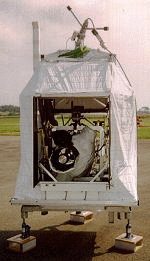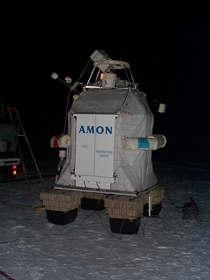Purpose of the flight and payload description
AMON is a balloon-borne UV-Visible spectrometer aimed to obtain vertical profiles of O3, NO2, NO3, OClO and of the extinction coefficient of aerosols for altitudes ranging from 15 to 40 km. It is composed of a 20-cm Cassegrain telescope with a 1-meter focal length, a grating spectrometer, and a CCD detector. The instrument is mounted in a stabilized gondola developed by the Geneva Observatory.
AMON observations are performed by the stellar occultation method, which consists in analyzing, during the setting of a star, recorded spectra that are affected by atmospheric absorption by the species that are present in the lines of sight of the star. At a balloon float altitude of 34-39 km, depending on the flight conditions, first a reference spectrum is recorded when the star is a few degrees above the horizon of the gondola in which the instrument is riding. Raw spectra are then recorded while the star is setting under the gondola's horizon. Transmission spectra are obtained by division of the star's occultation spectra by the reference spectrum. The spectrometer covers, continuously, the ultraviolet-visible spectral domains in five spectral bands. The vertical resolution of this instrument is ~0.5 km.
The first technological flight of AMON was carried out in 1991, since then until 1998, AMON was the only balloon-borne instrument making measurements at night in this spectral range and thus the only instrument measuring NO3 from the stratosphere. From AMON measurements, it was shown the possibility of the presence of OBrO species as was predicted by models. Nowadays these measurements are taken regularly by the SALOMON instrument developed by the same laboratory.
Details of the balloon flight
Balloon launched on: 2/11/1999 at 20:10
Launch site: European Space Range, Kiruna, Sweden
Balloon launched by: Centre National d'Etudes Spatiales (CNES)
Balloon manufacturer/size/composition: Zero Pressure Balloon model 100z 100.000 m3
Balloon serial number: 100Z Nº 102
End of flight (L for landing time, W for last contact, otherwise termination time): 2/12/1999 at ~ 1:00
Balloon flight duration (F: time at float only, otherwise total flight time in d:days / h:hours or m:minutes - ): 4 h 47 m
Campaign: THESEO (Third European Stratospheric Experiment on Ozone) take place during 1998-99 to improve the understanding of the causes of ozone depletion over Europe and other mid-latitude regions. It involved more than 400 scientists from over 20 countries.
Payload weight: 832 kgs
Gondola weight: 495 kgs
In the frame of the preparation of the validation of the GOMOS instrument on board the European satellite ENVISAT, ESA has founded the development of AMON-RA (AMON-RApid), a low resolution spectrometer flying on board the AMON gondola which records ten spectra per second of the star observed by AMON. AMON-RA allows the study of the chromatic scintillation, a phenomenon that comes from the deviation of the star light rays through the atmospheric layers with different temperatures. This was the first flight of the instrument.
External references
- List of balloons launched from ESRANGE SSC Space website (via Archive.Org)
- The AMON Instrument: Absorption by the Minor components Ozone and Nox Atmospheric Chemistry Data Centre
1293If you consider this website interesting or useful, you can help me to keep it up and running with a small donation to cover the operational costs. Just the equivalent of the price of a cup of coffee helps a lot.



